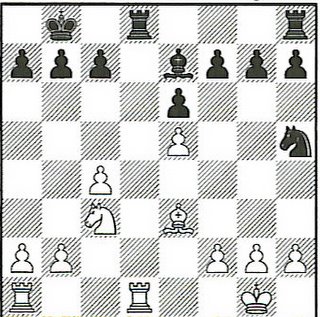The Make or Break Game: Analysis
It's a little late, but I've been a little busy! Anyway, here's my analysis (with Fritz' input as well). My failings in this game can be attributed mainly to a combination of misplaying the opening and not looking hard enough for my own resources in the position.
NN(1598) - CelticDeath(1493) [B01]
TCCC Normal, IL, 11/29/2005
B01: Scandinavian Defence 1.e4 d5 2.exd5 Nf6 3.d4 Bg4 4.Be2 Bxe2 5.Qxe2 Qxd5 6.Nf3 e6 7.0–0 Nc6 8.Rd1 0–0–0 9.Be3

I struggled with the correct place to put my bishop. I didn't want to cut off the communication between my queen and rook, but apparently (and counterintuitively, d6 is the best spot for the bishop to go.
9. ... Be7 [Fritz: 9...Bd6 10.c4 (10.Nc3 Qh5 11.Qb5 Qg6 12.Qb3 a6; 10.Bg5 Qf5 11.c4 Be7 12.Be3) 10...Qf5 (10...Qh5 11.Nc3 Kb8 12.h3) 11.Nc3] 10.c4 Qh5 11.Nc3 Kb8 12.Ne5 Nxe5 13.Qxh5 Nxh5 14.dxe5

Here, I make another 2nd best move that gets me into trouble. I never even considered Fritz's recommended move.
14. ... g6 [Fritz: 14...f5!? is worthy of consideration] 15.g4+- Ng7 16.Bh6 Rhg8 17.Rxd8+ Bxd8 18.Rd1 Kc8 19.Nb5

Now, my position is difficult, but tenable with accurate play. Unfortunately, I blunder.
19. ... c6?? Fritz: the position is going down the drain [19...a6 20.Na7+ Kb8 21.Bxg7 Kxa7] 20.Nd6++- Kc7 21.Bxg7 Be7 22.Bh6 g5 23.Bg7 Bxd6 24.exd6+ Kd7 25.Bf6 Rg6 26.Be7 e5 27.Kg2 h6 28.Kf3 Re6 29.Ke4 b6 30.b4 f6 31.Rd3 Rxe7 32.dxe7+ Kxe7 1–0
NN(1598) - CelticDeath(1493) [B01]
TCCC Normal, IL, 11/29/2005
B01: Scandinavian Defence 1.e4 d5 2.exd5 Nf6 3.d4 Bg4 4.Be2 Bxe2 5.Qxe2 Qxd5 6.Nf3 e6 7.0–0 Nc6 8.Rd1 0–0–0 9.Be3

I struggled with the correct place to put my bishop. I didn't want to cut off the communication between my queen and rook, but apparently (and counterintuitively, d6 is the best spot for the bishop to go.
9. ... Be7 [Fritz: 9...Bd6 10.c4 (10.Nc3 Qh5 11.Qb5 Qg6 12.Qb3 a6; 10.Bg5 Qf5 11.c4 Be7 12.Be3) 10...Qf5 (10...Qh5 11.Nc3 Kb8 12.h3) 11.Nc3] 10.c4 Qh5 11.Nc3 Kb8 12.Ne5 Nxe5 13.Qxh5 Nxh5 14.dxe5

Here, I make another 2nd best move that gets me into trouble. I never even considered Fritz's recommended move.
14. ... g6 [Fritz: 14...f5!? is worthy of consideration] 15.g4+- Ng7 16.Bh6 Rhg8 17.Rxd8+ Bxd8 18.Rd1 Kc8 19.Nb5

Now, my position is difficult, but tenable with accurate play. Unfortunately, I blunder.
19. ... c6?? Fritz: the position is going down the drain [19...a6 20.Na7+ Kb8 21.Bxg7 Kxa7] 20.Nd6++- Kc7 21.Bxg7 Be7 22.Bh6 g5 23.Bg7 Bxd6 24.exd6+ Kd7 25.Bf6 Rg6 26.Be7 e5 27.Kg2 h6 28.Kf3 Re6 29.Ke4 b6 30.b4 f6 31.Rd3 Rxe7 32.dxe7+ Kxe7 1–0

3 Comments:
Hey Celtic,
Much greater chess minds than I have
said not to take chess engines'
suggestions in non-tactical situations too seriously.
Granted, the BEST engines nowadays play a pretty good positional game, but I don't see what kind of insight is gained from the computer's Bd6 as opposed to your Be7. Perhaps some higher-rated players out there might offer a clue?
Funky
I was actually able to drum up some outside support for Bd6 by looking back at my repertoire book (and I think I saw it in a few of Fritz' database games as well). On the plus side, d6 is a more active square for the bishop, which apparently outweighs the fact that it cuts the line between queen and rook. Fritz had judged the move to d6 as better, but I think the difference between it and the move I chose was only evaluated differently by about a tenth of a pawn.
Hi there my Celtic friend :)
Just wanted to let you know that your comments have been read, and all i can say is; I'm Dutch. And i don't worry that much ;)
Post a Comment
<< Home